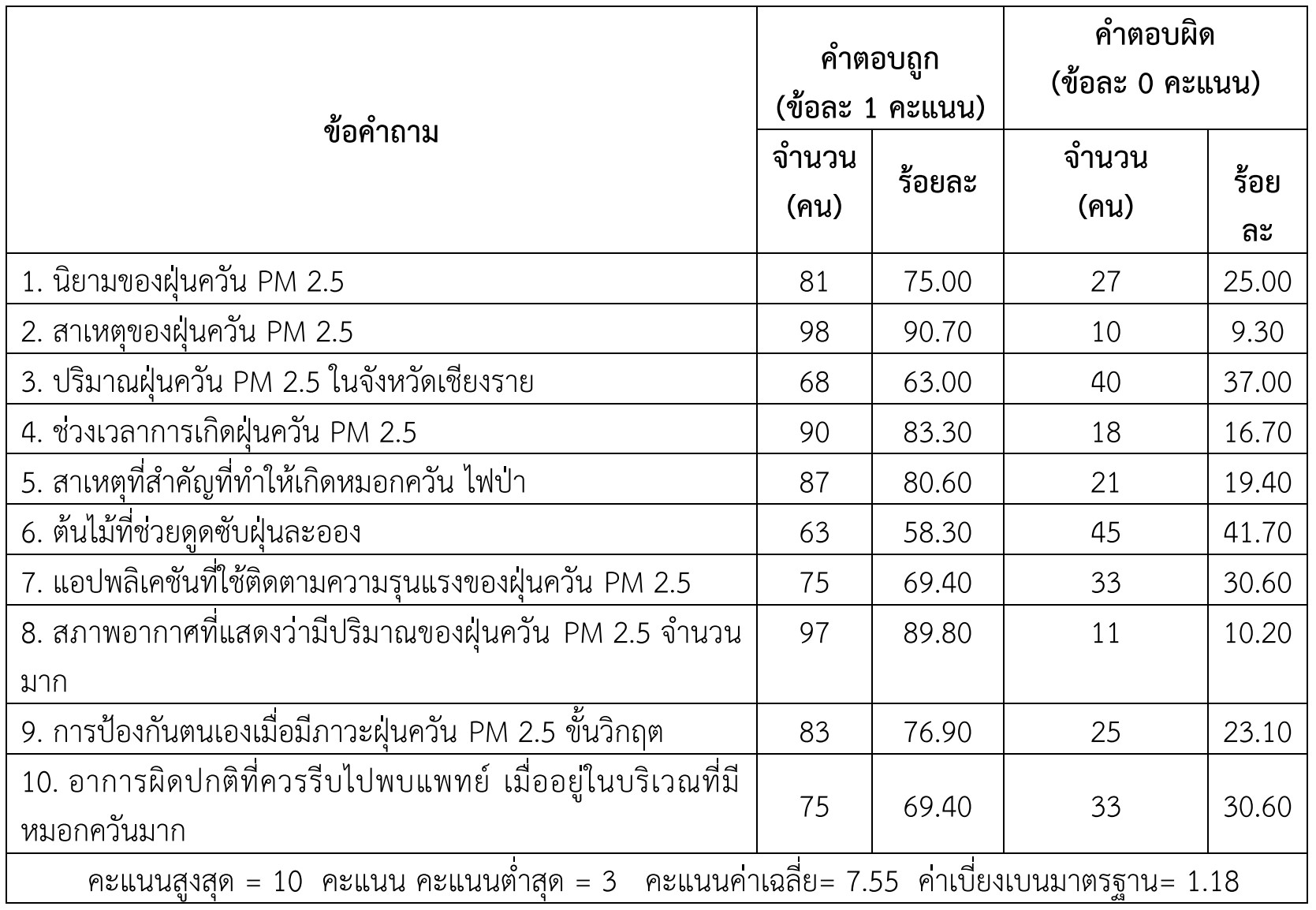The perceptions of pregnant women towards PM 2.5 pollution
Main Article Content
Abstract
The objective of this mixed methods research was to study pregnant women's perceptions of particulate matter 2.5 microns (PM 2.5) pollution in Chiang Rai Province. The quantitative study collected data from 108 pregnant women using stratified random sampling. The tools were a questionnaire to measure knowledge about prevention and health care when exposed to PM 2.5, and a measure of awareness of problem solving and health care when PM 2.5 occurred. The questionnaire had a reliability between 0.51 - 0.89. The data were analyzed using descriptive statistics. The qualitative study collected data by conducting in-depth interviews with 10 purposively selected pregnant women. The data were analyzed using content analysis and triangulation. The results found that pregnant women had a mean score of 7.55 in knowledge about prevention and health care in the event of PM 2.5 pollution, with a standard deviation of 1.18. They had the highest awareness of abnormal signs and symptoms when in a place with a large amount of PM 2.5, with a mean of 4.58, a standard deviation of 0.55, and had the least awareness of monitoring the severity of the PM 2.5 problem, with a mean of 4.31, a standard deviation of 0.65. In addition, they need information on how to self-care and deal with problems when faced with PM 2.5 pollution, as well as cooperation from all sectors to prevent and reduce PM 2.5. Therefore, education for pregnant women to keep themselves safe from PM 2.5 and cooperation from all sectors in preventing and reducing PM 2.5 pollution should be promoted.
Article Details
References
กระทรวงทรัพยากรธรรมชาติและสิ่งแวดล้อม. (2566). กก.วล. ยกระดับค่ามาตรฐาน PM 2.5 ราชกิจจาฯ ประกาศบังคับใช้แล้ว. [ออนไลน์]. เข้าถึงได้จาก: https://www.pcd.go.th/pcd_news/26385. (วันที่ ค้นข้อมูล: 24 สิงหาคม 2566).
ขนิษฐา ชัยรัตนาวรรณ และณัฐพศุตม์ ภัทธิราสินสิริ. (2563). แหล่งกำเนิด ผลกระทบและแนวทางจัดการฝุ่น ละออง PM 2.5 บริเวณภาคเหนือของประเทศไทย. วารสารสมาคมนักวิจัย, 25(1), 461-74.
ราชวิทยาลัยกุมารแพทย์แห่งประเทศไทยและสมาคมกุมารแพทย์แห่งประเทศไทย. (2566). แถลงการณ์จากราช
วิทยาลัยกุมารแพทย์แห่งประเทศไทย สมาคมกุมารแพทย์แห่งประเทศไทย สมาคมโรคระบบหายใจและ
เวชบำบัดวิกฤตในเด็ก สมาคมโรคภูมิแพ้ โรคหืดและวิทยาภูมิคุ้มกันแห่งประเทศไทย เรื่อง มลพิษ PM 2.5 ต่อสุขภาพเด็กและทารกในครรภ์ วันที่ 22 กุมภาพันธ์ พ.ศ. 2566. [ออนไลน์]. เข้าถึงได้จาก: https://www.thaipediatrics.org/?p=2258. (วันที่ค้นข้อมูล: 24 สิงหาคม 2566).
ศิริลักษณ์ เจริญรัมย์ และวิสาขา ภู่จินดา. (2564). ทัศนคติของประชาชนต่อแนวทางการแก้ไขฝุ่นละอองขนาดไม่
เกิน 2.5 ไมครอน กรุงเทพมหานคร. วารสารวิจัยรำไพพรรณี, 15(2), 70-78.
สุภางค์พิมพ์ รัตตสัมพันธ์, นิธินันท์ ศิรบารมีสิทธิ์ และชนินทร รัตตสัมพันธ์. (2565). ความสัมพันธ์ระหว่างความ รอบรู้ด้านสุขภาพกับพฤติกรรมการป้องกันการสัมผัสฝุ่น PM 2.5 ของหญิงตั้งครรภ์ โรงพยาบาล ปทุมธานี. วารสารพยาบาลสงขลานครินทร์, 42 (3), 53-62.
สำนักงานบริหารนโยบายของนายกรัฐมนตรี (2563). จากไฟป่า ถึง PM 2.5 ปัญหาเร่งด่วนปัญหาที่ทุกคนต้อง ร่วมกันแก้. [ออนไลน์]. เข้าถึงได้จาก: https://www.pmdu.go.th/wildfire-to-pm2- 5. (วันที่ค้นข้อมูล: 10 พฤศจิกายน 2566).
สมฤกษ์ กาบกลาง, อภิญญา บ้านกลาง และนันธินีย์ วังนันท์. (2564). การรับรู้ผลกระทบต่อสุขภาพและ
พฤติกรรมการป้องกันตนเองจากฝุ่นละอองขนาดเล็กไม่เกิน 2.5 ไมครอนของประชาชน ในเขตเทศบาลนครขอนแก่น อำเภอเมือง จังหวัดขอนแก่น. วารสารวิทยาลัยบัณฑิตเอเซีย, 11(2), 115-123.
Erlingsson, C., & Brysiewicz, P. (2017). A hands-on guide to doing content analysis. African Journal
of Emergency Medicine, 7(3), 93-99.
Fold, N. R., Allison, M. R., Wood, B., Thao, P., Bonnet, S., Garivait, S., … Pengjan, S. (2020). An assessment of annual mortality attributable to ambient PM 2. 5 in Bangkok, Thailand. International journal of environmental research and public health, 17(7298), 1-13.
Good, C. V. (1973). Dictionary of education. New York: McGraw-Hill.
Ha, S., Hu, H., Roussos-Ros, D., Haidong, K., Roth, J., & Xu, X. (2015). The effects of air pollution
on adverse birth outcomes. Environment Research, 134, 198-204.
Hsieh, H. F., & Shannon, S. E. (2005). Three Approaches to Qualitative Content Analysis.
Qualitative Health Research, 15(9), 1277-1288.
Hu, H., Ha, S., Henderson, B. H., Warner, T. D., Roth, J., Kan, H., & Xu, X. (2015). Association of atmospheric particulate matter and ozone with gestational diabetes mellitus. Environmental Health Perspectives, 123(9), 853-859.
Li, C., Xu, J., Zhou, F., Ge, Y., Qin, K., Huang, H., & Wu, Y. (2023). Effects of particulate matter on
the risk of gestational hypertensive disorders and their progression. Environmental science & technology, 57, 4930-4939.
Li, Q., Wang, Y., Guo, Y., Zhou, H., Wang, X., Wang, Q., … Xu, M. (2018). Effect of airborne particulate matter of 2.5 μm or less on preterm birth: A national birth cohort study in China. Environment International, 121, 1128-1136.
Liu, C., Li, Q., Yan, L., Wang, H., Yu, J., Tang, J., … Guo, Y. (2019). The association between maternal exposure to ambient particulate matter of 2.5 μm or less during pregnancy and fetal congenital anomalies in Yinchuan, China: A population-based cohort study. Environment International, 122, 316–321.
Liu, H., Liao, J., Jiang, Y., Zhang, B., Yu, H., Kang, J., … Xu, S. (2019). Maternal exposure to fine particulate matter and the risk of fetal distress. Ecotoxicology and Environmental Safety. 170, 253-258.
Michikawa, T., Morokuma, S., Yamazaki, S., Yoshino, A., Sugata, S., Takami, A., … Nishiwaki, Y. (2020). Maternal exposure to fine particulate matter and its chemical components increasing the occurrence of gestational diabetes mellitus in pregnant Japanese women. Japan Medical Association, 5(4), 480-490.
Su, X., Zhao, Y., Yang, Y., & Hua, J. (2020). Correlation between exposure to fine particulate matter and hypertensive disorders of pregnancy in Shanghai, China. Environmental Health, 19(101), 1-8.
Su, Y., Li, C., Xu, J., Zhou, F., Li, T., Liu, C., … Huang, H. (2023). Associations between short-term and long-term exposure to particulate matter and preterm birth. Chemosphere, 313, 1-10.
United States Environmental Protection Agency. (2023). Particulate Matter (PM) Basics. [Online].
Available: https://www.epa.gov/pm-pollution/particulate-matter-pm-basics#PM. Accessed Aug. 23, 2023.
Wojtyla, C., Zielinska, K., Wojtyla-Buciora, P., & Panek, G. (2020). Prenatal fine particulate matter
(PM2.5) exposure and pregnancy outcomes-analysis of term pregnancies in Poland. Environmental Research and Public Health, 17, 1-10.
World Health Organization. (2019). Health effects of particulate matter. [Online]. Available: https://www.euro.who.int/__data/assets/pdf_file/ 0006/189051/ Health-effects-of-particulate- matter-final-Eng.pdf. Accessed Aug. 23, 2023.
Wu, J., Laurent, O., Li, L., Hu, J., & Kleeman, M. (2016). Adverse reproductive health outcomes and exposure to gaseous and particulate-matter air pollution in pregnant women (Research report). Boston: Health Effects Institute.
Zhang, M., Mueller, N. T., Wang, H., Hong, X., Appel, L. J., & Wang, X. (2018). Maternal exposure to ambient particulate matter ≤2.5 μm during pregnancy and the risk for high blood pressure in childhood. Hypertension, 72, 194-201.
Zhao, Y., Cai, J., Zhu, X., Donkelaar, A. V., Martin, R. V., Hua, J., & Kan, H. (2020). Fine particulate matter exposure and renal function: A population-based study among pregnant women in China. Environmental International, 141, 1-8.


